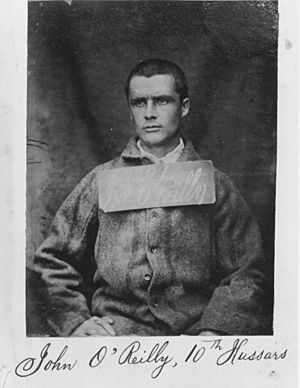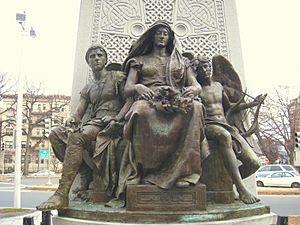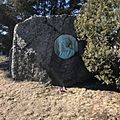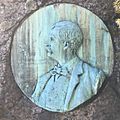John Boyle O'Reilly facts for kids
Quick facts for kids
John Boyle O'Reilly
|
|
|---|---|
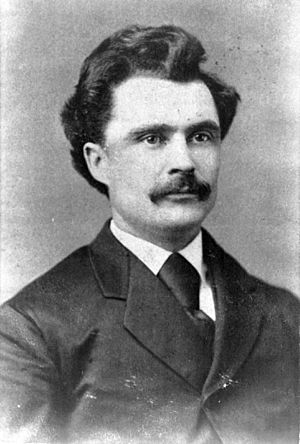
O'Reilly in 1871
|
|
| Born | 28 June 1844 Dowth, County Meath, Ireland |
| Died | 10 August 1890 (aged 46) Hull, Massachusetts, U.S. |
| Resting place | Holyhood Cemetery, Massachusetts, U.S. |
| Occupation | Journalist, poet, fiction writer |
| Period | 1873–1890 |
| Notable works | Moondyne |
| Spouse | Mary Agnes Murphy (m.1872–90; his death) |
| Children | 4 |
John Boyle O'Reilly (born June 28, 1844 – died August 10, 1890) was an important Irish poet, journalist, and activist. When he was young, he joined a group called the Irish Republican Brotherhood, also known as the Fenians. Because of this, he was sent as a prisoner to Western Australia.
After a daring escape to the United States, he became a strong voice for the Irish community. He did this through his work as editor of the Boston newspaper The Pilot. He also wrote many books and poems and gave speeches across the country. His famous works include the novel Moondyne and poems like The Cry of the Dreamer. O'Reilly is remembered for his writing and his efforts for civil rights.
Contents
Early Life in Ireland
John Boyle O'Reilly was born on June 28, 1844, at Dowth Castle, near Drogheda, Ireland. His father, William David O'Reilly, was a school principal. John was the third of six children. At this time, Ireland was part of the United Kingdom. Many Irish people wanted to be free from British rule.
A year after O'Reilly was born, the terrible Great Famine began. This event deeply affected O'Reilly's life and beliefs. While his close family survived, many of his classmates died because of the famine. John received a good education from his father. When he was about 13, he started working as an apprentice at a local newspaper.
Moving to England
In 1859, when he was 15, O'Reilly moved to Preston, Lancashire, England. He lived with his aunt and uncle. He found work at a local newspaper called the Preston Guardian. In 1861, he joined a military training group called the 11th Lancashire Rifle Volunteers Corps.
In 1863, O'Reilly returned to Ireland and joined the British Army. However, he soon became unhappy with British rule. He saw how British policies were hurting Irish Catholics. Because of this, he left the army shortly after.
Joining the Fenians
O'Reilly and the Irish Republican Brotherhood
In 1864, O'Reilly joined the Irish Republican Brotherhood. This was a secret group of rebels, often called the "Fenians." Their goal was to start an armed rebellion against British rule in Ireland. O'Reilly worked hard to recruit more Fenians within his army regiment. He helped bring in up to 80 new members.
In February 1866, O'Reilly and many other Fenians were arrested by British authorities. He was sent to Arbour Hill military prison. On June 27, 1866, the day before his 22nd birthday, O'Reilly's trial began. He was charged with treason, which means betraying one's country.
He was found guilty and sentenced to death. However, because of his young age, his sentence was changed. First, it became life imprisonment, and then 20 years of hard labor as a prisoner. For about 15 months, he was held in famous English prisons like Millbank and Dartmoor. During this time, O'Reilly tried to escape twice but was quickly caught.
Sent to Australia
On October 10, 1867, O'Reilly was put in chains. He was marched to a prison ship called the Hougoumont. On board were 61 other Fenian prisoners and 218 common criminals. They were all being sent to the British colony of Western Australia. This was known as penal transportation.
During the long journey, O'Reilly and another prisoner, John Flood, created a handwritten newspaper. They called it The Wild Goose. It included poems, stories, and jokes from the prisoners. Seven editions were made. The Hougoumont was the last ship to transport prisoners to Western Australia.
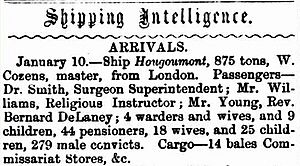
The ship arrived in Fremantle, Australia, on January 9, 1868. O'Reilly was first taken to the Convict Establishment, which is now Fremantle Prison. After a month, he was moved to Bunbury. There, he was assigned to a group of prisoners building a road.
O'Reilly became friends with his warder, Henry Woodman. He was even made a probationary convict constable. This meant he helped with record-keeping and other small tasks. He often traveled between the work camp and the prison in Bunbury.
Planning an Escape
While in Bunbury, O'Reilly became good friends with Father Patrick McCabe, a local Catholic priest. In late 1868, Father McCabe offered to help O'Reilly escape from the colony. By February 1869, the plan was ready.
On February 18, 1869, O'Reilly left his work group without permission. He met up with James Maguire, a local settler. They rode to Geographe Bay, where a small boat was waiting. O'Reilly hid in the sand dunes, waiting for an American whaling ship called the Vigilant. Father McCabe had arranged for this ship to pick him up.
The next day, the ship was seen. O'Reilly and his friends rowed out to it. But the captain changed his mind and sailed away. O'Reilly had to return to shore and hide again. His friends tried to make arrangements with another ship. After two weeks, they succeeded. They made a deal with the captain of another American whaler, the Gazelle.
O'Reilly and his friends met the Gazelle about 3 miles (5 km) out at sea on March 2. He was taken on board. Another prisoner, Martin Bowman, also joined the escape.
While on the Gazelle, O'Reilly became friends with the first mate, Henry Hathaway. Hathaway even saved O'Reilly's life. During a whaling trip, a wave hit their boat, and O'Reilly was knocked unconscious. Hathaway performed cardiopulmonary resuscitation to save him.
Father McCabe had planned for the Gazelle to take O'Reilly only to Java. But bad weather prevented the ship from going through the Sunda Strait. The captain decided to sail to Rodrigues, which was a British colony. When the Gazelle arrived, police boarded the ship. They had information that an escaped prisoner from Western Australia was on board. The crew gave up Bowman, but they denied that O'Reilly was there.
The Gazelle's next stop was Saint Helena, another British colony. The captain told O'Reilly to transfer to another ship before then. On July 29, the Gazelle met an American cargo ship called the Sapphire at sea. O'Reilly moved to this ship. The Sapphire arrived in Liverpool, England, on October 13. O'Reilly then transferred to another American ship, the Bombay. The Bombay docked in Philadelphia, USA, on November 23, 1869. There, Irish friends warmly welcomed O'Reilly.
Soon after arriving in Philadelphia, O'Reilly went to New York. He gave a lecture on December 16, 1869, where he shared details of his escape. O'Reilly soon realized that Boston would be a better place for his goals. He moved there, arriving on January 2, 1870.
Life in America: Writing and Activism
Early Years and Journalism
O'Reilly settled in Charlestown, a neighborhood in Boston with a large Irish community. He gave his first lecture in the United States on January 31, 1870. It was called "England's Political Prisoners." The lecture was a success, and he was asked to repeat it in other cities. Later that year, he became a reporter for The Pilot newspaper.
In June 1870, O'Reilly traveled to Canada to report on the Fenian Invasion of Canada. He was on the front lines of every event during this failed invasion. This was O'Reilly's first major work for The Pilot.
Marriage and Family Life
On August 15, 1872, O'Reilly married Mary Murphy (1850–1897). She was also a journalist. They had four daughters: Mary, Eliza, Agnes, and Blanid. Their oldest daughter, Mary Boyle O'Reilly, later became a journalist and war correspondent. Their third daughter, Agnes O'Reilly, married the philosopher William Ernest Hocking.
The Catalpa Rescue
In 1875, a group called the Clan na Gael wanted to rescue six Fenian prisoners still held in Western Australia. They asked O'Reilly for advice. O'Reilly suggested a plan: instead of attacking the prison, they should buy a whaling ship. This ship would look like it was there for normal business. Then, a rescue party would pick up the escapees at a secret meeting point.
O'Reilly's plan was followed, and it led to the famous Catalpa rescue. The escape was successful! O'Reilly received the good news in June 1876.
John Boyle O'Reilly's Poetry
O'Reilly published his first book of poems, Songs from the Southern Seas, in 1873. Over the next 15 years, he published three more poetry collections. He also wrote a novel and a book about health and exercise. His poetry was very popular. He was often asked to write poems for important events.
While much of his early work is now seen as popular verse, some of his later, more thoughtful poems are still highly regarded. His best-known poem is The Cry of the Dreamer. On November 14, 1888, O'Reilly read his poem honoring Crispus Attucks at a memorial dedication.
In his later years, O'Reilly often felt unwell and had trouble sleeping. He published his last poem, The Useless Ones, in The Pilot on February 1, 1890.
John Boyle O'Reilly's Death
On August 9, 1890, O'Reilly went to his home in Hull, Massachusetts. He had been struggling with insomnia. That evening, he took a long walk with his brother-in-law, hoping to get tired enough to sleep. Later that night, he took some of his wife's sleeping medicine, which contained a substance called chloral hydrate.
In the early morning of August 10, around 2 or 3 a.m., his wife found O'Reilly unconscious in a chair. She sent for the family doctor, who tried to revive him for nearly an hour. However, O'Reilly died shortly before 5 a.m. Public announcements said he died of heart failure. But the official death record listed "accidental poisoning" as the cause.
Tributes and Funeral
O'Reilly's sudden death brought a huge wave of sadness and tributes from Boston and around the world. The Pilot newspaper published a full story of his life. Important figures like former President Grover Cleveland and Senator George Frisbie Hoar sent their condolences. His parish priest, Reverend J. W. McMahon, praised him as a "single-minded, open-hearted man" who loved liberty.
His funeral on August 13, held at St. Mary's Church in Charlestown, was attended by thousands. The streets were filled with mourners. O'Reilly was first buried in Calvary Cemetery in Roxbury. But in November 1890, his remains were moved to Holyhood Cemetery in Brookline.
Legacy and Honors
In 1891, James Jeffrey Roche, O'Reilly's assistant editor, wrote a book about O'Reilly's life. O'Reilly became one of the most famous and respected journalists and writers in the United States. On June 20, 1896, a bronze statue of O'Reilly was unveiled in Boston. President Grover Cleveland gave a speech at the event.
Many famous people admired O'Reilly, including poets like Walt Whitman and Oscar Wilde, and politicians like John F. Kennedy.
The John Boyle O' Reilly Club opened in 1880 in Springfield, Massachusetts. In the early 1900s, a housing estate in Dundalk, Ireland, was named Boyle O'Reilly Terrace.
In the mid-1980s, an Irish researcher named Liam Barry discovered O'Reilly's escape story. He helped share the story and published books about O'Reilly. Around 1987, The John Boyle O'Reilly Association was founded in Bunbury, Australia. In 2002, a special display about John Boyle O'Reilly was opened in Western Australia.
In 2019, a festival called the Moondyne Walk was held in Fremantle. It celebrated the 150th anniversary of O'Reilly's escape. During the festival, different people read chapters from his novel Moondyne.
Works by John Boyle O'Reilly
- Songs from the Southern Seas (1873) – a collection of poems
- Songs, Legends and Ballads (1878) – a collection of poems
- Moondyne (1879) – a novel based on his experiences as a prisoner in Western Australia
- The Statues in the Block (1881) – a collection of poems
- In Bohemia (1886) – a collection of poems
- The Ethics of Boxing and Manly Sport (1888) – a book about health and exercise
- Watchwords (1891) – published after his death
Images for kids
See also
- List of convicts transported to Australia


